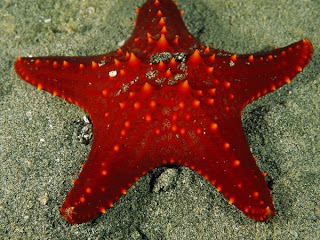I have always had a fascination with starfish, and every other creature in the phylum Echinodermata. When I was younger I would get so excited to go the tide pools and spend hours investigating this other world in the rocks. Before I changed it to Political Science I was set to major in Zoology with a minor in Marine Biology. To this day my marine biology classes with all the field trips to local beaches and aquariums hold my fondest memories of any college course.
Starfish come in many different sizes and colors but the one thing they all have in common is their star shape. Even though starfish live under the water and are known as starfish. They are not fish. They differ in many ways. Fish have gills and scales, and they swim through the water with their fins. Starfish lack gills, scales, and fins; instead they use their tiny tube feet to move along the ocean floor.
Starfish are classified in the Class Asteroidea. All asteroids have several arms arranged around a central disk. Asteroidea are known as the "true stars.
Because they are symmetrical by five points, just like sea urchins, they are also in the Phylum Echinodermata.
If you have ever encountered a starfish and turned it over, you will find hundreds of projections on its underside. These are known as tube feet, which serve two basic functions - one being able to move around in the water, and the other to open up scallops or clams.
An interesting fact about the starfish is that it has two stomachs. The cardiac stomach can help the starfish engulf food outside its body. When the cardiac stomach comes back into the body, the food in it is transferred to the pyloric stomach.
Have you ever tried locating the mouth of a starfish? It is located on the ventral surface, underneath the upper surface.
The sea star with five arms is the most commonly spotted one. However, there are species that have 10, 20, or even up to 40 arms!
The starfish has an eye spot at the end of each arm; although not much detail can be seen, the eye spot enables the starfish to view movement and differentiate between light and dark.
Most starfish have a spiky or leathery surface, depending upon the species. The crown-of thorns starfish is known for its thorny spines that are present all over its body. This tough covering on the upper side of the body acts as protection from its predators, as it is made up of calcium carbonate plates with tiny spines.
In addition to no brain, these sea animals do not have a single drop of blood in their body. Instead, they have a water vascular system, and sea water is pumped into the body through a sieve plate.
Amazingly, in case a starfish loses its arm, it is capable of regenerating the same in about a year! This is extremely useful when the sea star feels threatened by a predator, as it can lose the arm and escape. Sometimes, an entirely new starfish can grow from one arm. This phenomenon takes some time and occurs as most of the vital organs are stored in the arms.
The anus of this invertebrate is located on top of its body.
These marine animals have a unique way of feeding on their prey. To be able to eat a prey that is larger than its mouth opening, the starfish wraps its arms strongly around the clams or shells, and then jerks it open. Then it pushes the stomach out into the shell and eats up the prey, and finally retracts the stomach back in through the mouth.
Another interesting fact about starfish is that they can reproduce sexually and asexually. Eggs and sperms are sent off by the females and males respectively, in the mating season.
A female starfish is capable of producing around a million eggs at one time.
An unbelievable yet amazing fact is that starfish can change their gender whenever they want.
Sources:







No comments:
Post a Comment
Let me know what's up??